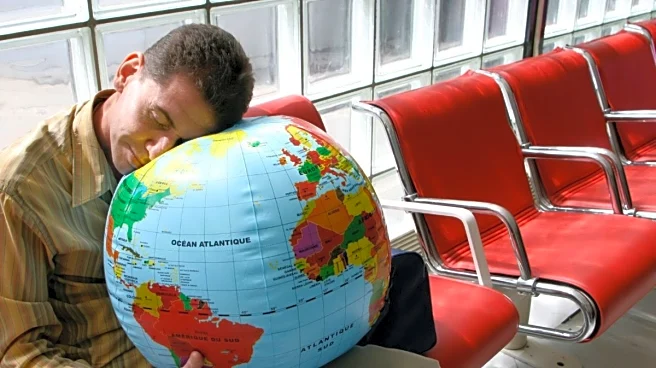The Jet Lag Cure That’s Not a Pill
For years, travellers have tried to outsmart jet lag with melatonin pills, blackout curtains, and caffeine tricks. But new research from Stanford University suggests that the real cure might not come from a tablet at all, it might come from light and timing.
Scientists now say that how and when you expose yourself to light, and even when you eat, can reset your body clock faster than any supplement. And it also explains why the return flight home almost always feels worse.
Why Jet Lag Feels Like Borrowed Time
Jet lag is the body’s way of protesting time travel. Your brain and body run on a 24-hour rhythm called the circadian clock. It tells you when to sleep, eat, and wake up, guided mostly by sunlight. When you fly
across time zones, that rhythm goes out of sync with the new day–night cycle.
This desynchronization leads to the familiar symptoms – sleeplessness, daytime fatigue, brain fog, digestive issues, and a sense of being half-awake in the wrong world. Eastward travel is usually harder because your body must fall asleep earlier than it’s used to. Westward travel, which delays your schedule, is slightly easier because your internal clock naturally drifts later each day.
So why do return flights often feel worse? Because coming back home usually means advancing your body clock, forcing it to sleep and wake sooner than it wants. Add exhaustion from the trip, irregular meals, and overstimulation, and the body rebels.
The Body’s Hidden Clocks
We often imagine one central body clock, but the truth is more complex. The brain’s master clock, located in the suprachiasmatic nucleus, synchronizes thousands of smaller clocks in organs like the liver, gut, and muscles. While sunlight resets the master clock, food timing resets many of the peripheral ones.
When these internal clocks fall out of sync with each other, it’s not just sleep that suffers, metabolism, digestion, and mood do too. That’s why scientists say recovery from jet lag isn’t just about sleeping at the right hour, but re-timing all of these biological systems together.
The Light Trick That Outsmarts Melatonin
Stanford researchers studying circadian rhythm found that short, controlled bursts of light could shift the body clock faster than continuous light or melatonin supplements. In the study, volunteers exposed to brief flashes of bright light, each lasting just a couple of milliseconds, repeated over several minutes – experienced a two-hour delay in their circadian rhythm overnight.
Here’s why that matters. Melatonin tells your body it’s night time, but it doesn’t control the clock itself; it just reinforces what’s already happening. Light, however, is the real pacemaker.
Specialized cells in the retina detect brightness and send signals to the brain that adjust sleep and wake timing. These “light flashes” essentially fool the brain into thinking dawn or dusk has shifted, resetting the body’s internal clock more efficiently than a slow hormonal signal can.
The flashes also avoid the fatigue that comes from prolonged light exposure, giving the biological system time to reset between pulses. Researchers believe that controlled exposure to bright light at the right time of day could one day replace pills entirely as a jet lag therapy.
Why When You Eat Matters Too
If light is your body’s master switch, food is the backup generator. Studies at UCLA and other research centres show that timing your meals to the new time zone helps synchronize the body’s peripheral clocks.
When you eat, the body releases metabolic hormones like insulin and leptin, which tell organs when to process energy. Eating at odd hours confuses this system, making you feel hungry at midnight and sluggish during local lunchtime.
The new approach to jet lag combines both cues. Before your flight, gradually shift your meal and sleep schedule closer to your destination time. On the plane, avoid heavy meals, especially during the hours that would be night time at your destination.
Once you land, have your first full meal in sync with local breakfast or lunch, even if you’re not hungry. This gives your gut clock a reset signal, helping the rest of your system catch up.
The Real Science Behind Return-Flight Fatigue
The human body naturally prefers to delay its clock, to go to bed later rather than earlier. That’s why adjusting eastward (like returning to India from Europe or the US) feels harder than adjusting westward.
The problem compounds on return journeys because the traveller is already running on a delayed rhythm from the trip itself. You’ve eaten late, slept late, and absorbed light from a different hemisphere. By the time you’re home, your body clock is a full day or two behind local time.
Scientists call this “circadian misalignment,” where the brain has adapted to one schedule, but the body’s organs are still lagging. The result is a tug-of-war between systems, you might feel sleepy but your digestion is wide awake, or your brain is alert while your muscles feel drained.
A Real-World Recovery Plan
Experts now recommend thinking of jet lag not as a single problem but as a coordination challenge – aligning the different systems of the body through timed exposure. Here’s what a practical schedule might look like for an eastward trip (say, San Francisco to Bengaluru):
Before you fly:
Shift your bedtime and wake-up time earlier by about an hour each night for two to three days. Eat dinner earlier too. Reduce late-night screen use to limit blue light exposure.
On the flight:
Avoid heavy meals and alcohol. Stay hydrated. If you can, try to sleep during the hours that correspond to night time at your destination.
On arrival:
Get outside in the morning and spend at least 30 minutes in sunlight. Eat a solid breakfast, even if your appetite feels off. Avoid afternoon naps longer than 20 minutes.
Over the next few days:
Stick to local meal times. If your body resists sleeping early, use dim light and relaxation routines rather than screens. A small dose of melatonin (under guidance) can help for the first two nights, but consistency is key.
Why This Matters Beyond Travel
Jet lag is just one visible form of circadian disruption. The same misalignment happens to night-shift workers, frequent commuters, and anyone who stays up scrolling through blue-lit screens past midnight. Chronic circadian disruption has been linked to metabolic disorders, weakened immunity, and mood instability.
What the Stanford and UCLA findings highlight is that managing light and food exposure isn’t just for travellers, it’s a daily health tool. The same principles that reduce jet lag can improve everyday sleep quality and mental clarity.
The Future: Personalized Light Therapy
Researchers are now exploring portable light devices that mimic the Stanford “flashing light” protocol – wearable visors or sleep masks that deliver timed pulses while you rest. In the near future, travelers might be able to program their light exposure according to flight routes and time zones, creating personalized circadian schedules.
The goal is not just faster recovery, but full synchronization, a body that adjusts seamlessly to global movement.
The next time you step off a long flight feeling half-awake, remember that your body isn’t broken – it’s just behind on its schedule. Light, not pills, is the strongest medicine for that. Eat in sync, step into the sun, and give your body cues it can trust.
Jet lag isn’t about distance, it’s about rhythm. And learning to play that rhythm well might be the ultimate travel skill of the future.





/images/ppid_a911dc6a-image-176058223801068355.webp)

/images/ppid_59c68470-image-176058760522166435.webp)





/images/ppid_a911dc6a-image-176034643507766012.webp)


